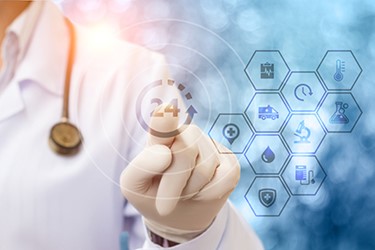5 Medical Procedures Revolutionized By MedTech
By Kayla Matthews, Productivity Bytes

Medical technology has undergone a dramatic transformation over the last century. Conditions that were once fatal are now simple to treat with antibiotics, surgery or similar solutions. With innovations in MedTech, the healthcare industry has changed for the better.
With that in mind, here are seven procedures and technologies that MedTech has revolutionized in recent years.
1. Neuro Sensors
Sensors that connect directly to the brain are a vital tool for the treatment of a variety of neurological conditions. They're often inconvenient, however, as they necessitate wires, and the openings where the sensors attach can allow bacteria to enter the skull.
In 2016, Gelest Inc created a new type of plastic called elastomers, which can remain in the body without the need for removal. The body absorbs the elastomers when they've fulfilled their function.
With this advancement in MedTech, neurologists no longer need to rely on traditional sensors. They can position the wireless elastomer sensors and close up the patient, reducing the chance of infection. The sensors dissolve in several days, so there's no reason to repeat the surgery for removal.
2. Cancer Therapies
Current cancer therapies, while effective, tend to affect the entire body rather than just the cancer cells. They're often damaging, with serious side effects that reduce the patient's quality of life during treatment. So, what if we could take those same drugs and make them only target the malignant cells within a patient's body? That's where cancer nanotherapy enters the equation.
Nanotherapy relies on capturing cancer treatment drugs in nanoparticles. These nanoparticles then target the malignant cells and deliver the drugs directly where they're needed, rather than treating the patient's entire body.
3. Asthma Inhalers
According to the Centers for Disease Control, one out of every 13 people has asthma. This includes more than 25 million people in the United States alone. Nearly all of them can control their condition with the use of an inhaler, but only 12 percent of those patients use their inhaler correctly. MedTech is starting to change this, affecting the way we look at something as simple as an inhaler.
Bluetooth-enabled smart inhalers could help asthma sufferers control their condition more effectively by recording the date, time and GPS location where the dose was taken. It also can assess whether or not the user is operating the inhaler correctly to help them learn proper techniques for managing their asthma.
4. Myomectomies
Uterine fibroids are benign growths in the uterus that cause pain and heavy periods, among other symptoms. Many women believe that the only way to treat fibroids is a hysterectomy, but there are new, less invasive options that don't require the removal of the woman's reproductive organs. Fibroid mapping can help treat these non-cancerous growths without the need for major abdominal surgery.
Instead of entering through the abdomen, fibroid mapping relies on a catheter inserted through the patient's thigh. One by one, the catheter moves to the arteries that are supplying the fibroids with blood, cutting off blood supply to the growths and causing them to shrink.
Instead of major surgery, this laparoscopic procedure takes only about an hour, and the patient can go home the same day. It's less invasive than a hysterectomy and leaves behind no scarring on the abdomen at all.
5. Electrocardiograms
An electrocardiogram, or ECG, is something a patient would only receive in the hospital or a doctor's office. But now, a patient can get an ECG by wearing an Apple or Samsung watch. Apple took the MedTech industry by storm in 2014 when they released their Series 4 Apple Watch with ECG capabilities. Samsung's newest incarnation of their Galaxy Watch 2 would have the same capabilities, though the ECG function won't be available at its launch in September.
While a smartwatch with ECG capabilities is no replacement for a trip to the doctor, it can help patients monitor their heart health and catch problems early on that might only show up intermittently.
Some have even found that the information provided by their Apple Watch's ECG matched what was generated by hospital-grade equipment. The only difference was that the Apple Watch is essentially a single lead, so it makes it harder to pinpoint where a problem is occurring, an issue that hospital ECGs don't have. Apple's watch also can alert the wearer if it detects an abnormal heartbeat.
Looking Toward The Future
Medical technology is still evolving and will continue to change in the years to come. The advances listed above are impressive, of course, but these innovations are only a small part of a much bigger picture.
MedTech is changing more than the standard practices for uterine fibroids, cancer treatments and other procedures. It will shift the landscape in many ways as enterprising minds come up with more ideas to improve the patient experience through technology.
About The Author
Kayla Matthews is a MedTech writer whose work has appeared on HIT Consultant, Medical Economics and HITECH Answers, among other industry publications. To read more from Kayla, please connect with her on LinkedIn, or visit her personal tech blog at https://productivitybytes.com.
